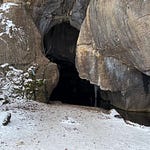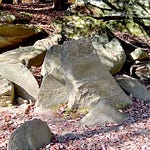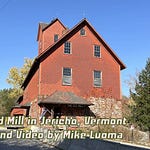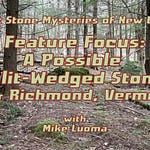In this hollow, tucked away in woods near Bolton and Jericho, several ancient stone constructs lie partially collapsed, half-covered by leaf clutter and forest duff. I shared one of the first I came across in an earlier post:
This site seemed to reveal itself feature by feature, each stone construct leading me to the next. And though I spied about a half-a-dozen, there may be additional constructs which still lie even more collapsed and buried out of the sight of my seeking eyes.
Two other bedrock outcrops across the hollow, short little ridges, were built upon, but their stonework is now in disarray and collapse. We’ll look at them another time. The construction around this exposed rock remains more intact, though its intended form may be no easier to determine. What was it meant to be, if anything?
When we look closer, some curious details emerge. This is a planned and well-constructed stonework, despite its current condition. Many of the stones are somewhat intricately connected. This leads me to believe it could be much older than many might consider possible. And it may have been maintained for a very long time, until recently, couple hundred years or so.
Click on any square Gallery Photo to See the Full Picture.






It seems to be an aquatic form, given the shapes and positioning of some of the stones.
Yes, I think we see the involvement of shaped stones. No, this is not the professional consensus — many archaeologists, geologists and anthropologists argue against the possibility Indigenous peoples in the northeast of what’s now North America shaped stones at this scale, conceding only stone-on-stone pecking of surfaces and flaking of tools and projectile points. What I’ve seen in the field leads me to beg to differ — I think we see larger, shaped stones.
Speaking of special stones, we also see the careful placement and use of quartz in this assemblage, likely indicative of Indigenous construction. And, again, this apparent Indigenous Stonework seems to involve shaped stones, or, perhaps, stones chosen for their unique natural shapes, if the idea of shaping itself is not “allowed”. At least one of these “shaped” stones features a prominent quartz vein, and looks like a fin.









This stone assemblage struck me as aquatic, somewhat fish-like, at my first approach, though the broad and over-prominent front “fin” — seemingly indicated by the low, semi-circular stonework section built upon the left side — didn’t fit this idea, not at first. But, then, it did. I realized how old this could be, how long this feature might have been maintained, comprehending it might actually look like a Flying Fish.
So far as I’m aware, the only real Flying Fish live in the ocean. We’re nowhere near the ocean in Northwestern Vermont. Well, not now. This hollow, however, lies near the ancient shores of Vermont’s glacial lakes and the Champlain Sea, and was apparently part of the earliest area deglaciated in the Champlain Valley. But that was, of course, a very long time ago.
And yet? Before there was Lake Champlain, a larger Champlain Sea filled the Champlain Valley and stretched up through what’s now Canada, connecting to the Atlantic Ocean. Which allows us to speculate that, about 10,000 years ago, at the end of the Ice Age, an oceanic Flying Fish could have frolicked in the waters in an inlet of the Champlain Sea not far from here…
…And inspired this stonework? Seems a bit of a reach. Still, I can’t shake the sense it appears to be a Flying Fish Effigy Form.

What do you think? Have a look at the Newsletter Exclusive video and let me know in the comments. I’ll be bringing you more of these mysterious stone structures from this stonework site on this website, in this Substack Newsletter, in the near future.
The video features a short piece of a musical composition by Kevin MacLeod.
Music Credits:
Healing by Kevin MacLeod
Link: https://incompetech.filmmusic.io/song/3860-healing
License: http://creativecommons.org/licenses/by/4.0/

















Share this post